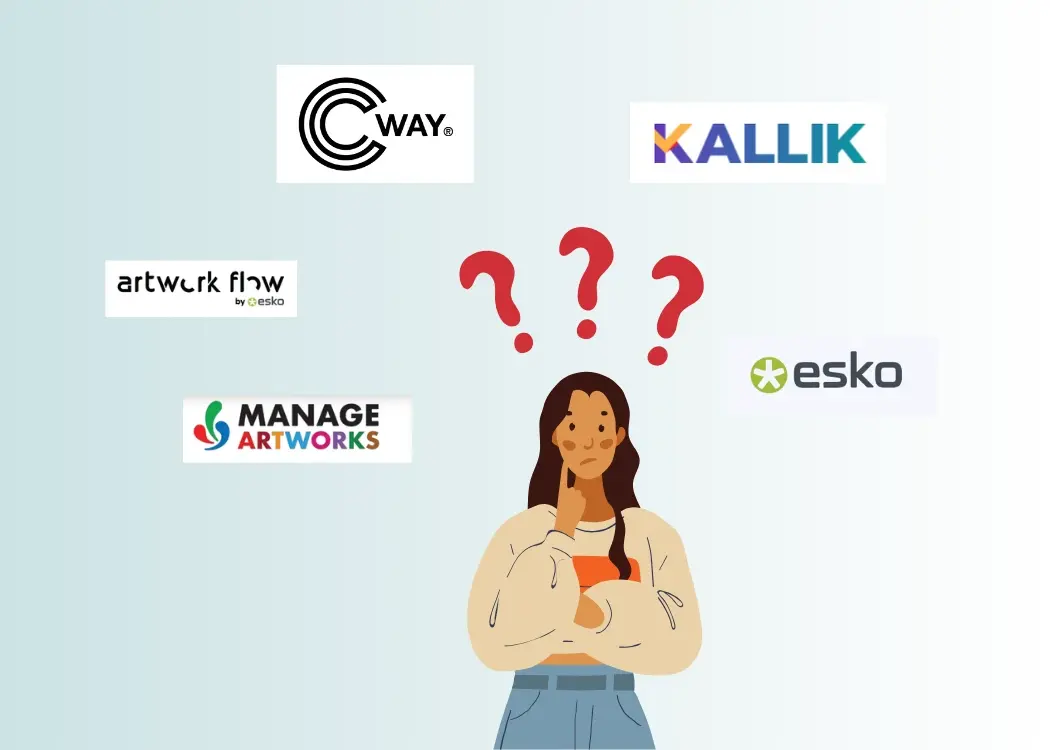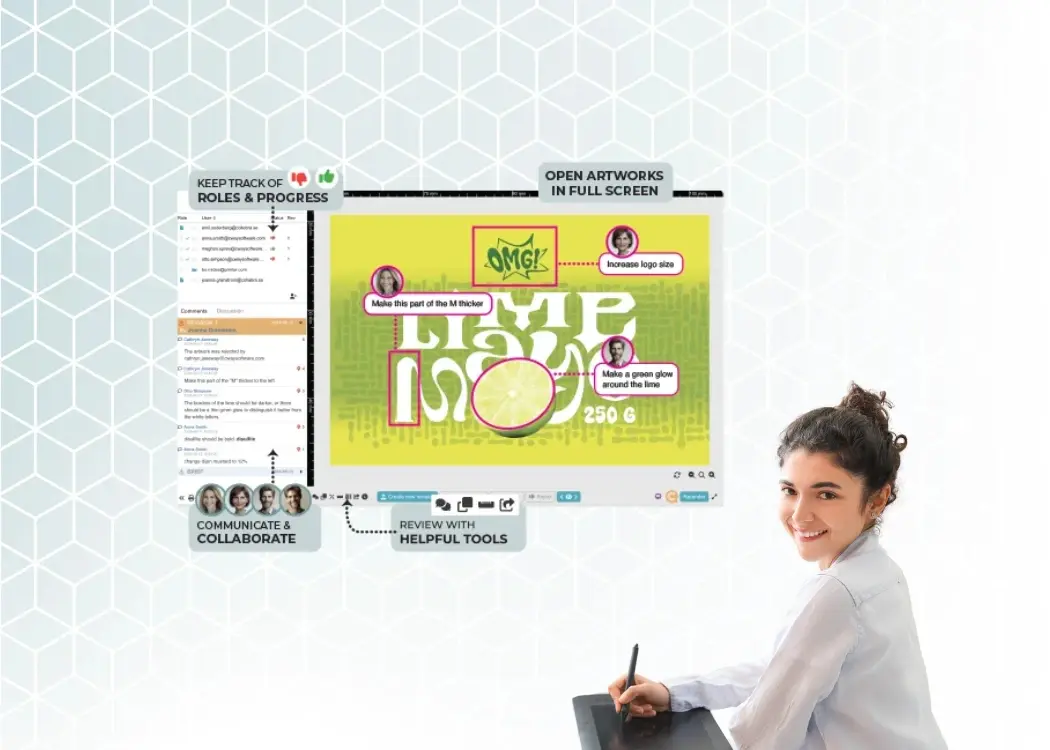Best 7 artwork management solutions for packaging teams in 2025
If you're part of a team that creates packaging—whether it’s for yoghurt tubs, medicine boxes, or shampoo bottles—you know how tricky it can be to...
7 min read
 Ekaterina Skalatskaia
:
September 2, 2025 at 7:15 AM
Ekaterina Skalatskaia
:
September 2, 2025 at 7:15 AM

If your team creates packaging—whether it’s for yoghurt tubs, medicine boxes, or shampoo bottles—you know how challenging it can be to manage all files, approvals, and last-minute changes. That’s where packaging management software comes in. These tools reduce delays, prevent revision loops, and eliminate errors by keeping everything—files, tasks, and approvals—in a centralized system.
This guide highlights the top 5 packaging management solutions in 2026. You’ll see how each platform works, what it’s best for, and why Cway stands out as the most packaging-focused solution on the market.
Every product on the shelf tells a story, and behind each package is a team juggling a hundred moving parts. The brand manager wants the design to shine and stay true to the brand. Marketing wants approvals yesterday. Regulatory insists every word is legally perfect. Agencies are coordinating across multiple product lines, and the production team just needs files that are truly print-ready.
Now, imagine trying to manage all of that with emails, spreadsheets, and PDFs bouncing around. It’s chaotic. Deadlines slip, versions get lost, and someone inevitably asks, “Wait, which is the final version?”
That’s where packaging management software steps in—without the jargon. It’s the tool that keeps everyone on the same page, tracks every change, and ensures nothing slips through the cracks.
You’re launching a new oat milk in five countries. Each market has slightly different legal text, translations, and printers. On top of that, one team—maybe even a third-party agency—is developing the product’s visual identity: logos, icons, and other design elements. But the brand has its own established design system, so every new product line must fit perfectly into that framework.
As the project progresses, the design for this new line is likely to be revised multiple times. That means you need a clear version history, safe storage for original design files, and a reliable way to track every change. Meanwhile, the 3D packaging mock-ups are created by a completely different team. Their work has to align perfectly with the 2D design and match the final look that will appear on store shelves.
To complicate things further, the production of the physical packaging is outsourced—your manufacturer can’t handle it in-house, so a third-party printing house steps in. Now, imagine if the printing house changes midway through production. How do you ensure that the new printer reproduces the packaging exactly—same colors, same quality, same finishes—so the final product is consistent across markets?
Without a centralized system, each of these moving parts—design teams, 3D artists, legal checks, translations, and multiple printers—can quickly become a chaotic tangle of emails, PDFs, and spreadsheets. With the right packaging management software, however, every file, comment, and approval is stored in one place. Version histories are tracked, responsibilities are clear, and every stakeholder—from the brand team to the printing house—can work confidently, knowing the product that eventually hits the shelf is exactly as intended.
The big picture: Every stage of the packaging journey—design, review, approval, production, and storage—needs to connect seamlessly. Modern tools like Cway, ManageArtworks, and Kallik help teams collaborate efficiently, keep records straight, and make sure products hit the shelves without a hitch.
Need Better Control Over Your Artwork Process?
Learn how teams can manage approvals, comments, and revisions in one place.
Not all packaging management tools are created equal. Choosing the right solution can save your team hours of frustration, prevent costly errors, and ensure every product hits the shelves perfectly. Here’s a deeper look at the features to evaluate:
One Platform for Every Packaging Project
Unify teams, agencies, and approvals with Cway for smoother, faster workflows. Request your free consultation today!
Here are the most trusted packaging management solutions, tailored for different team needs:

Why It Stands Out
Cway® is a specialized software built to simplify and speed up the management of packaging and artwork projects. Made for teams handling large volumes of product assets—especially in fast-moving or regulated industries—Cway turns complex workflows into smooth, auditable, and fully transparent processes.
By organizing creative collaboration, Cway® minimizes errors, accelerates approval cycles, and enables teams to launch products faster while maintaining complete control and visibility.
Top Features:
Best For:
Packaging teams, agencies, or FMCG brands who want fast results and clear control.
Get hands-on with the Cway platform—no strings attached. Explore project apps, try the version compare tool, upload your own artworks, and see what a packaging-first system can really do.
✅ No credit card required
✅ Full access to project & media center tools
✅ Personalized onboarding session available

Why It Stands Out
This platform focuses on compliance and traceability. ManageArtworks is offered by Karomi Technology, a company specializing in cloud-based packaging and artwork lifecycle management systems for the pharmaceutical and consumer packaged goods (CPG) industries.
Top Features:
Automated approval paths: By automating workflows and enforcing role-based tasks, the platform helps standardize approval processes and reduce dependency on manual follow-ups.
Regulatory tracking: The platform is designed with industries like pharmaceuticals and consumer packaged goods in mind, making it well-suited for environments where regulatory compliance and traceability are non-negotiable.
Vendor access control: ManageArtworks is capable of managing large-scale operations with geographically dispersed teams. This is valuable for global brands managing localized packaging across markets.
Best For:
Small and medium-sized packaging and marketing teams
Pros:
Great for global teams
ManageArtworks provides plugins for Adobe tools, allowing designers to work within their familiar environment while syncing directly with the system
Cons:
There are reports of limited flexibility in customizing workflows and templates, which can be restrictive for organizations with unique processes.
Some users find the interface less intuitive, which can lead to a steeper learning curve and require additional training time.

Why It Stands Out
Filestage is a simple and clean tool for reviewing content. It works well if you deal with multiple file types like videos, brochures, and packaging.
Top Features:
Comment directly on files
Track who approved what
Clear feedback threads
Best For:
Agencies and marketing teams with lots of projects on the go
Pros:
Quick to start
Easy for clients to use
Cons:
Not built for packaging-specific needs like barcodes or dielines

Why It Stands Out
Esko is a heavyweight in packaging tools, used by major international brands.
Top Features:
Full packaging workflow from idea to print
Regulatory tracking
Integration with print production tools
Best For:
Big teams with complex workflows and global production partners
Pros:
Integrates with advanced prepress tools
Supports complex, multi-language packaging pipelines
Cons:

Why It Stands Out
Built specifically for life sciences, Kallik ensures your labels and packaging follow industry regulations.
Top Features:
Compliance tracking
Digital audit trail
Global language management
Best For:
Pharma and medical device companies
Pros:
Proven in high-risk industries
Tracks legal info across versions
Cons:
Not flexible for creative or fast-moving consumer brands
Choosing the right artwork management tool can feel daunting. There are plenty of platforms available, but not all are built with packaging in mind. Some excel at creative reviews, others focus on general task management. If your team handles packaging graphics, tight print deadlines, and product launches, you need a solution designed for those specific challenges.
Cway® is more than just an approval tool. Created by Collabra, a team experienced in managing packaging artwork for leading Scandinavian brands like Arla and Essity, Cway addresses real-world challenges—missed barcodes, lost approvals, and file chaos—head-on.
With Cway®, you benefit from:
Packaging-specific workflows ready to use right out of the box
Visual compare tool to catch even minor but critical changes
Seamless collaboration with all feedback stored in one place
A robust Media Center that keeps your artwork files organized and avoids duplicates
It’s intuitive, quick to learn, and flexible enough to grow with your team.
We suggest starting with a hands-on test. Bring in real artwork from your projects and see how each tool handles your workflow.
✅ Download our free guide: How to choose the right online proofing software
This guide breaks down key considerations—from collaboration features to file compatibility and onboarding time.
✅ Book a demo with Cway®: See how Cway manages your actual packaging workflow—no fluff, just practical tools to make your process easier.

If you're part of a team that creates packaging—whether it’s for yoghurt tubs, medicine boxes, or shampoo bottles—you know how tricky it can be to...

In this article, we’ll explore the top systems for packaging artwork traceability. From compliance to speed, learn how leading tools ensure every...

If your team struggles to manage packaging artwork across multiple stakeholders, you’re not alone. In this article, we’ll explore how artwork...